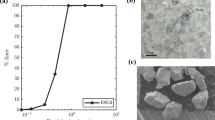Abstract
The boundary layer structure of oscillatory shallow open channel flows has been studied in a wide flume. Fluorescence solution was released at a porous rough bed through a diffuser covered by gravel of 0.5 cm grain size. A planar laser-induced fluorescence (PLIF) system was used to visualise the dye plumes in both vertical and horizontal planes for a qualitative understanding of the roles of large-scale flow structures in mass transport. A variety of tests were conducted for a range of oscillatory periods (30–240 s), water depths (3–16 cm) and velocity amplitudes (0.027–0.325 m/s), which cover a wide range of oscillatory flows with Reynolds numbers Re a varied from 0.3 × 104 (laminar) to 2.1 × 106 (fully turbulent). For quantitative investigation, a novel technique, namely combined laser-induced fluorescence (LIF) and 2D laser Doppler velocimetry (LDV) (LIF/LDV), was developed and used to measure the velocity and solute concentration simultaneously in a vertical plane over 50 cycles. From the dye plumes revealed by the PLIF in transitional flows, there are different patterns of flow structure and solute transport with three representative stages of acceleration, deceleration and flow reversal. In the acceleration stage, turbulence was suppressed with dye layers adhering to the surface with little vertical mass transport. In the deceleration stage, flame-like turbulent structures occurred when turbulence generation was prominent. This was investigated quantitatively by recording the percentage occurrence of the adhered smooth layers per cycle. For those smooth bed cases with Re a < 1.8 × 105, the adhered smooth dye layers type of boundary layer occupied 100% of the oscillation period. Over a sufficiently high Re a , a rough bed can generate fully turbulent oscillatory flows without the appearance of adhering dye layers. Between these two extremes, a transitional flow regime occurs in a wide range of flow conditions: Re a > 2.7 × 104 over the rough bed and Re a > 8.3 × 106 over a smooth bed.












Similar content being viewed by others
Abbreviations
- a :
-
amplitude of free stream motion
- D g :
-
median diameter of gravel
- H :
-
water depth
- K s :
-
Nikuradse’s roughness height
- K +s :
-
roughness Reynolds number
- Re a :
-
Reynolds number based on a
- Re δ :
-
Reynolds number based on Stokes thickness
- Re h :
-
Reynolds number based on water depth
- t :
-
real time
- T :
-
wave period
- u x , u y :
-
measured velocities in x and y direction from LDV
- U 0 :
-
amplitude of free stream velocity
- U, V:
-
ensemble averaged velocity in x and y directions
- u′, v′:
-
random turbulence velocities in x and y directions
- \({ - \overline{{{u}{'}{v}{'}}} }\) :
-
Reynolds stress
- \({ \tilde{U},\,\tilde{V}}\) :
-
wave phase-averaged velocities in x and y directions
- U fm :
-
maximum friction velocity
- x :
-
co-ordinate along the main flow direction in horizontal plane
- y :
-
co-ordinate in vertical direction from the bottom of flume
- δ:
-
laminar boundary or Stokes thickness
- δb :
-
oscillatory boundary layer thickness
- ω:
-
wave angle frequency
- ν:
-
kinematic viscosity
- ν t :
-
eddy viscosity
References
Chen D, Jirka GH (1999) LIF study of plane jet bounded in shallow water layer. J Hydraulic Eng 125:817–826
Chen D, Tang FE, Chen CQ (2005) Pollutant trapping at a coastal headland. J Waterway Port Coast Ocean Eng 131(3):98—114
Costamanga P, Vittori G, Blondeaux P (2003) Coherent structure in oscillatory boundary layers. J Fluid Mech 474:1–33
Fredsøe J, Deigaard R (1992) Mechanics of coastal sediment transport. World Scientific Publishers, Singapore
Hino M, Sawamoto M, Takasu S (1976) Experiments on transition to turbulence in an oscillatory pipe flow. J Fluid Mech 75:193–207
Hino M, Kashiwayanagi M, Nakayama A, Hara T (1983) Experiments on the turbulence statistics and the structure of a reciprocating oscillatory flow. J Fluid Mech 131:363–400
Jensen BL, Sumer BM, Fredsøe J (1989) Turbulent oscillatory boundary layers at high Reynolds numbers. J Fluid Mech 206:265–297
Jonsson IG, Carlsen NA (1976) Experimental and theoretical investigations in an oscillatory turbulent boundary layer. J Hydraulic Res 14(1):45–60
Justesen P (1988) Prediction of turbulent oscillatory flow over rough beds. Coast Eng 12:257–281
Li M, Pan S, O’Conner BA (2004) Acoustic back scattering measurements of sediment transport under sheet flow condition, Report No. CE/04/04, Department of Civil Engineering, The University of Liverpool, Liverpool, UK
Lloyd PM, Stansby PK, Chen D (2001) Wake formation around islands in oscillatory laminar shallow-water flows: part 1. Experimental investigation. J Fluid Mech 429:217–238
Nielsen P (1992) Coastal bottom boundary layers and sediment transport. World Scientific Publishing, Singapore
Sarpkaya T (1993) Coherent structures in oscillatory boundary layers. J Fluid Mech 253:105–140
Sleath JF (1987) Turbulent oscillatory flow over rough beds. J Fluid Mech 182:369–409
Vittori G, Verzicco R (1998) Direct simulation of transition in an oscillatory boundary layer. J Fluid Mech 371:207–232
Acknowledgement
This study is supported by a grant (GR/L/34570) from the UK Engineering and Physical Science Research Council (EPSRC). The three-dimensional LDV was made available from the EPSRC Instrument Pool. F.E. Tang was supported by a UK Overseas Research Studentship.
Author information
Authors and Affiliations
Corresponding author
Rights and permissions
About this article
Cite this article
Chen, D., Chen, C., Tang, FE. et al. Boundary layer structure of oscillatory open-channel shallow flows over smooth and rough beds. Exp Fluids 42, 719–736 (2007). https://doi.org/10.1007/s00348-007-0280-8
Received:
Revised:
Accepted:
Published:
Issue Date:
DOI: https://doi.org/10.1007/s00348-007-0280-8




